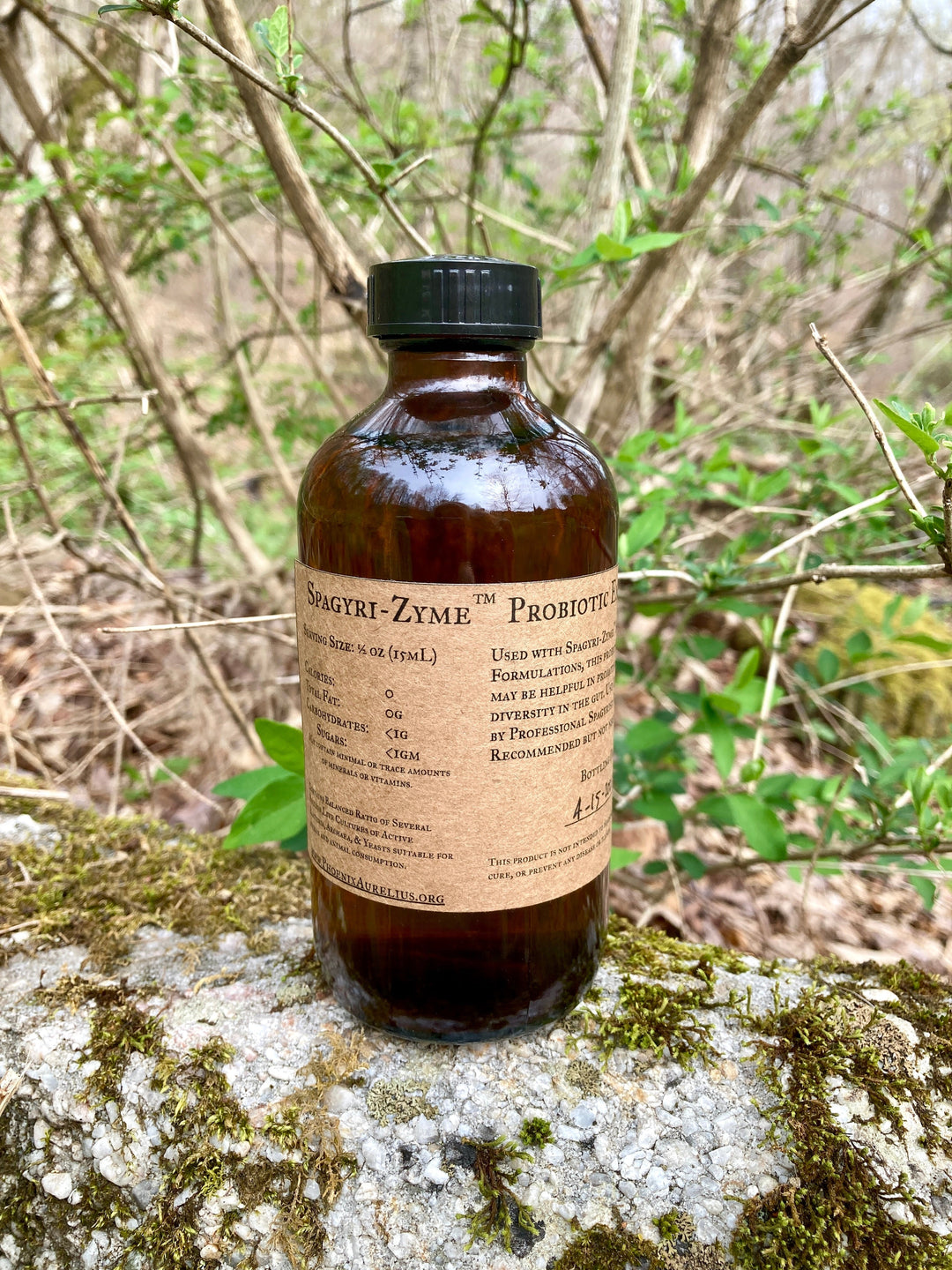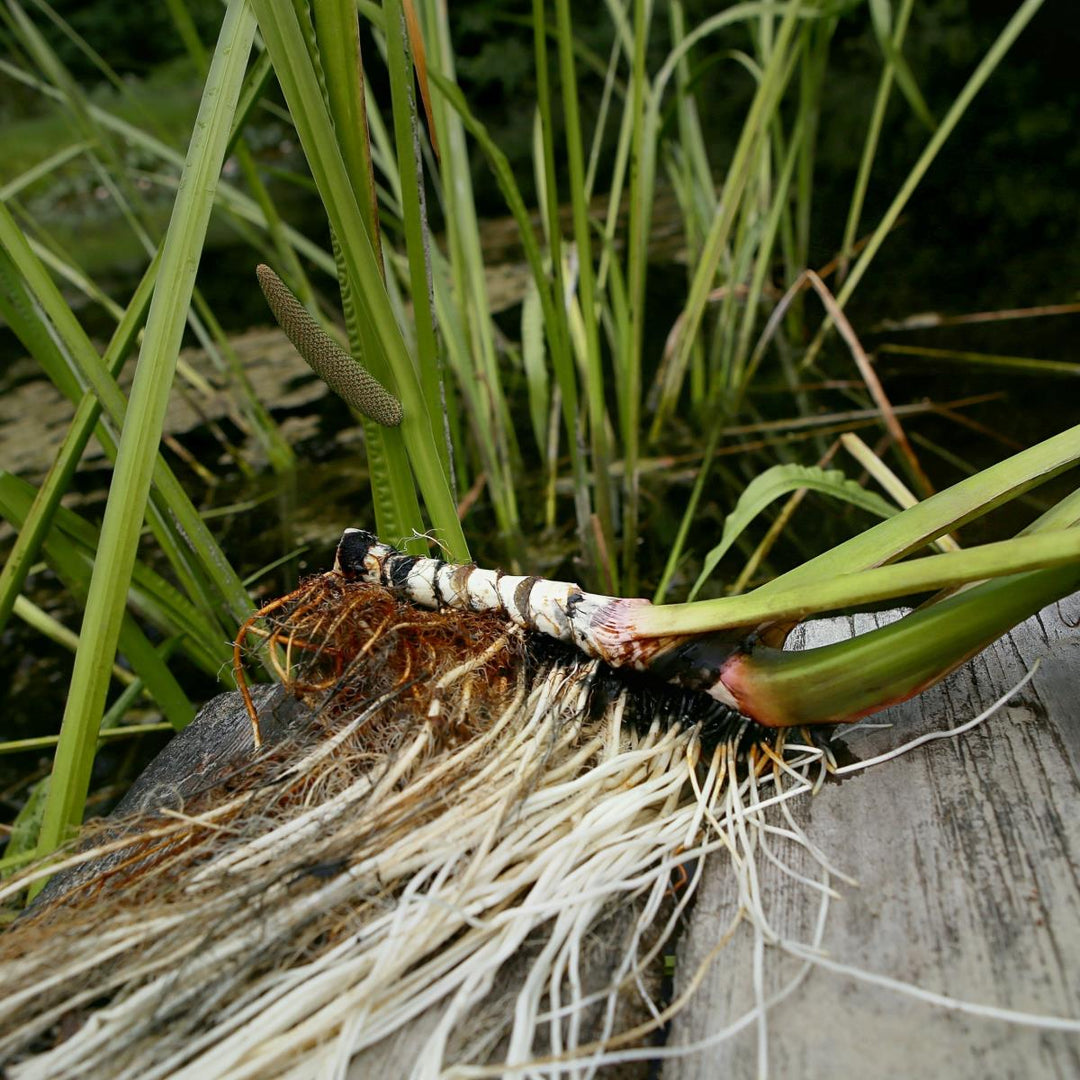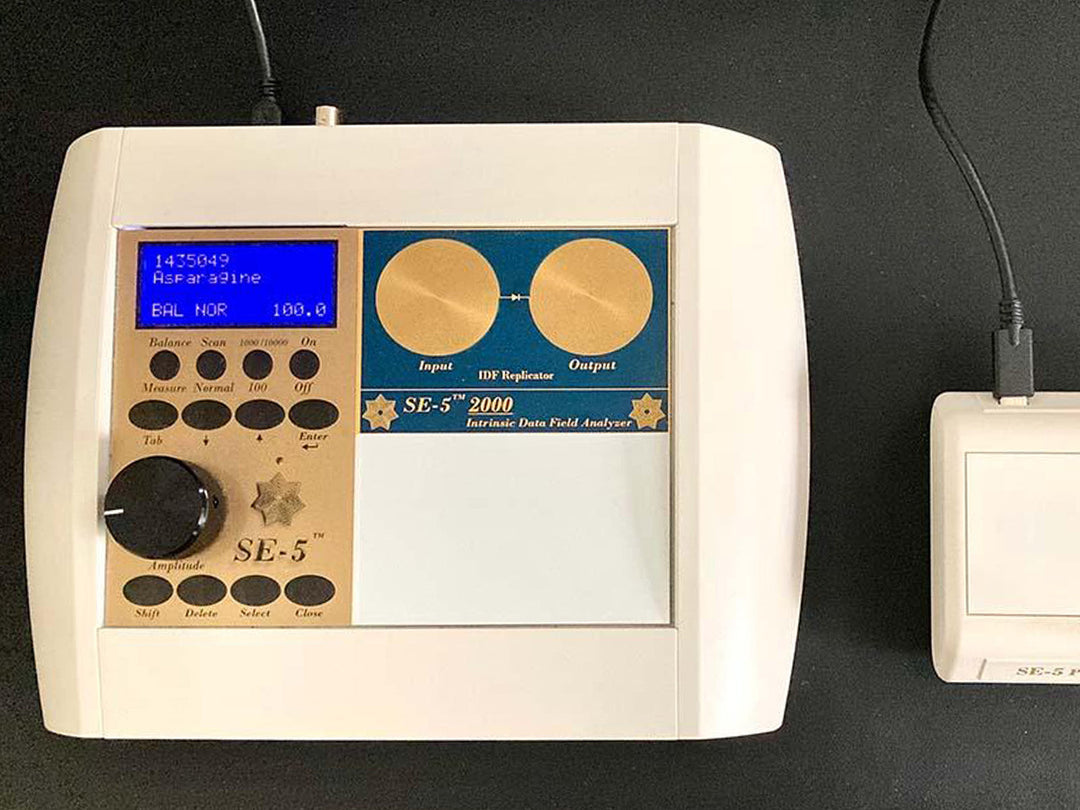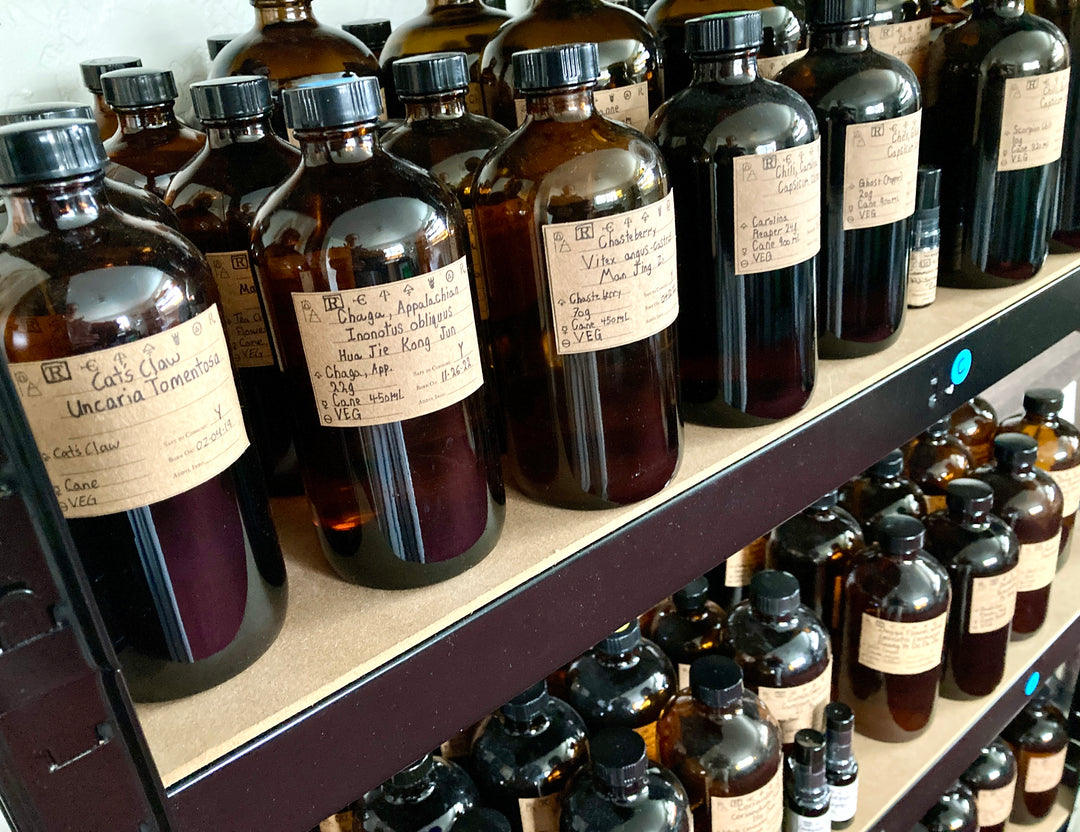Written by Phoenix Aurelius
What is Spagyri-Zyme Probiotic Enzyme?
Spagyri-Zyme Probiotic Enzyme is an odorless, mostly tasteless liquid microbial enzyme that contains a unique blend of many aerobic and anaerobic micro-organisms from soil, various water sources, compost, food materials, and more.
Multiple things make Spagyri-Zyme unique.
1: It is fully fermented and contains probiotics and postbiotics.
2: The unique formulation contains BOTH microbes as well as an enormous host of enzymes that are endogenously produced by the microbes. This blog will teach you a lot more about these microbes and the enzymes they produce as well as their applications in health, agriculture, and ecology.
Repeated testing through physical experimentation and SE-5 Analyses have shown that soil, plants, animals, and humans all thrive when exposed to Spagyri-Zyme Probiotic Enzyme. This product has been shown to restore healthy microbial balance to the digestive microbiomes of humans, cattle, sheep, chickens, dogs, cats, and other mammalian and fowl (not readily tested on reptiles or amphibians yet) as well as helps to produce Shikimic Acid (and other organic compounds) within a matter of hours after application. The results of prolonged exposure seem to indicate that this can help a person remediate the extremely important Shikimic Pathway of gut-related microbiota, which is absolutely necessary for the endogenous production of Serotonin, among other things. What we see is a much stronger Gut-Brain Axis among regular users of Spagyri-Zyme (Read about the Shikimic Pathway at the end of this blog)
Its ability to serve as a biochemical transmutation agent (learn more about Biological Transmutation by reading the works of Dr. Louis Kervran) is incredible! In soil tests undertaken at Desert Forge and Virgin Farms in the South Valley of the Rio Grande, they applied Crude Oil (pure Texas Tea) to the soil and then applied the base inoculant that Spagyri-Zyme is made from to the Crude Oil and then used a Rototiller to till it all under. In those studies, the inoculant was able to break through the paraffin and wax layers of crude oil and further decompose the oil into organic fertilizer in just 8 days! When the soil was analyzed after those 8 days, not only was no presence of petroleum of any sort detected, but the inoculant had converted all the toxic materials into their respective ionic minerals and supplied them in angstrom size to be directly available to the root systems! Moreover, the vitality of the soil went up drastically and the plants grown in that soil outperformed the control beds they tested it against in every single biomarker.
This blog will cover the story of how I developed the product and it will expose you to the key organisms and enzymes that are found within Spagyri-Zyme (listed below) and will help you understand how each of these organisms work within the human body, agriculture, and ecology.
Please note that at the time of publishing this article, we currently are only offering 4oz and 8oz sizes of Spagyri-Zyme Probiotic Enzyme on our online store, but if you would like to order this product in 5 gallon buckets for agricultural use, please email: support@phoenixaurelius.org. Please note that due to restrictions of storage space at our new temporary facilities in WV, we are incapable of storing the jugs for 1/2 gallon and 1 gallon sizes and are therefore not offering these sizes at this time. Also, please note that 5 Gallon Agricultural grade will look, smell, and taste MUCH DIFFERENT than the Food Grade Supplement we sell. We assure you that it is the same inoculant, but it's just not brought to completion, filtered, or prepared to be a food grade substance; as such, it is not safe to consume the agricultural grade product in the same way you would consume Spagyri-Zyme.
___________________________________________________________________________________________
How Phoenix Developed Spagyri-Zyme Probiotic Enzyme
In February 2018, I was exposed to a microbial inoculant by an Agricultural IDF Technician named Richard Kirby (who sadly passed away in December of 2024). He got this inoculant from a friend and colleague with whom he had been working for many years; he told me that he would send me a gallon of it to experiment with. Richard insisted that although it can be used to decompose crude oil and other hydrocarbons and treat septic systems, sewage, and manure, it was still safe to ingest and he strongly suggested taking it as a daily supplement along with grass-fed liquid whey. That said, I didn't really feel safe to ingest it at first without firsthand experimentation, so I started running some experiments.
One of the first things I did was to test its alleged microbial decomposition properties. I figured if it could break down crude oil, then it was likely it could break down just about any hydrocarbon. As a result, I applied several ounces of a special spagyric formula to a mason jar of the inoculant. If it had the ability to decompose hydrocarbons (the ethanol of spagyric tinctures is a hydrocarbon), then that would be apparent the next time the vessel was opened. When I came back 24 hours later and opened the sealed vessel, an enormous amount of gas and pressure escaped which smelled like rotten eggs. Looking back, some of this was likely hydrogen, carbon, and sulfur based gasses, even possibly containing some quantity of hydrogen sulfide (which could have been quite dangerous). Regardless, about 500mL of this inoculant had completely digested about 60mL of this Spagyric Formula, which is about 95% ethanol by volume! As we all know, ethanol itself at 95% is extremely strong and laboratories sterilize work surfaces with 70% ethanol. It is very antibacterial and antifungal - What's more is that I found this to be amazing considering that part of what was in the spagyric formula was oregano and other anti-bacterial herbs in addition to the actions of the ethanol. It was amazing that the solution could withstand such a massive antibacterial load!
After this, I repeated the experiment several times, even creating a consistent Spagyric Formula which I called "Spagyric Formula #1" to add to the Inoculant. I found that I could digest alcohol fully with a ratio of 1 part inoculant to 1.5 part ethanol. This was an outstanding discovery because the liquid inoculant could actually digest the hydrocarbons even when the volumetric quantity of the hydrocarbons were in greater supply than the inoculant! I then went on to test it on WD-40 and other toxic hydrocarbons with the same type of results. Having been introduced to Biological Transmutation by my dear friend and mentor, Art Kunkin, back in 2008, I knew that the microorganisms in this inoculant were obviously breaking things down microbially. So I asked Richard if he had a list of the organisms in the inoculant so I could begin cross-referencing with various soil organisms catalogued by UC Berkely.
Richard ended up telling me that they didn't have any affordable way of fully knowing all the microorganisms in the product, but he did have a list of at least some of the bacteria that were in the largest quantities in the product. He mentioned that there were synergistic colonies of all sorts of microbes, though, and he ran some IDF investigations to find out if there were any fungi and archaea in the solution, and the answers to both came up positive. The product has been repeatedly tested for pathogenic fungi, but it comes up negative; at present, there are no known pathogenic Archaea. None of the bacteria that were in the product were considered pathogens, either.
So, after this, I decided to produce another batch that I would prepare specifically with the intention of trying it as a supplement. I applied Spagyric Formula #1 to the product, let it ferment again like usual, then I took the material outside, allowed it off-gas fully and performed Biodynamic style Deep Vortex stirring with a clean wooden dowel for 1 hour each day over a period of a week. After that week, there were many solids that had precipitated out of the product (which are benign algae proteins), so I took the solution into the lab and started vacuum filtering it in successive order - first with 100 micron pre-filters, then 25 micron filters, then 10 micron filters, and finally down to 2 microns. I didn't want to get any lower than that because that would risk removing some of the microbes. The resulting product was an odorless liquid that had a slight yellow/pink hue to it, but completely translucent. I went ahead and tasted a few drops....it was clean and essentially tasteless, too. So, I placed a bit in an Amber Dropper bottle and went back to it everyday to take a few more drops. On several occasions, I had Richard run before and after IDF data to see what was happening with my vitality and various different systems of the body.
In every instance, even in dosages of 5-10 drops, my vitality spiked by about 200 points for the next 10 hours and the IDF readings of my Gastrointestinal, Endocrine, Neurological, and Immune Systems all went up by several percentage points. Working closely with Richard, we worked together for a while on the formula. During this time, I introduced Richard to OBIO Technology products that were initially developed by Dr. Oppenheimer such as Oppenheimer Formula IV, Aquazyme, and other products of that like. I also introduced Richard to a product known as "Stubble Digester" that Perry Martin had exposed to me during my early no-till beyond organic agricultural apprenticeship from 2006-2009.
Richard hadn't known that I had already done things that no Agriculturist thought was possible in an aquaponic environment. As we became closer, I shared the documentation of my aquaponic experiments using these products (mentioned above) in the fish tanks to not only eliminate diseases from the Tilapia and Goldfish, but also to grow very nutrient rich Tuscan Melons, Watermelons, Zucchini squash, Tomatoes, Wild Yam (dioscorea opposita), Strawberries, and a bunch of other produce in vertical Zip Grow and Pocket Towers in the aquaponic greenhouse I had during my time living in Portland (2015 - 2017). By using natural sources of Ionic Angstrom Minerals (from Mother Earth Minerals) along with EM-1 inoculant, Aquazyme, StoneBlood Shilajit, and performing subaquatic composting of various biomass grown in the greenhouse in bioponic fashion, we had outstanding success growing things we were told were impossible to grow in an aquaponic setup.
Richard had me send him some of these inoculants and allegedly found that some of these should be added to the primary fermentation of the Inoculant he and his business partner were making. After testing a batch, Richard said that he and his colleague thought that the product was even better, but they had no real way of paying me for the development, so we came to an agreement that I would be able to purchase this inoculant at an extremely affordable rate, he could alter it however he saw fit, and then we would be able to sell the product. This gave me access to gallons and gallons of this material to experiment with. Over the next three months, I tried lots of Spagyric Formulas in it and ran all sorts of experiments and tests.
At this point, I was primarily convinced that the microbes in the inoculant were doing all the work - and this was primarily because of my experience working with soil microbes from UC Berkely performing Biological Transmutation of elements in the ways shown to me by Art Kunkin. Then, when studying the shikimic pathway, I recognized that microbes with the shikimic pathway were producing shikimic acid (which is a metabolite) along with various enzymes and/or co-enzymes. This got me thinking about the actions of the inoculant I was using and I wondered what metabolites and enzymes might actually be produced.
So, I started looking into the known species of bacteria and found that all of these produce a host of different enzymes capable of breaking down an enormous range of substances, both organic and even some inorganic substances. By looking at the enzyme activity, I started testing enzymatic potency with Richard after adding various Spagyric Formulae to the inoculant. But with the new formulation, we weren't getting any greater vitality readings from inoculant treated with Spagyric Formulae than what we got from the updated inoculant. At this time, I stopped using Spagyric Formulae IN the product to make it, and instead researched how much more effective Spagyric Products would be if taken in a body that was regularly provided this inoculant. And that was where the real magic happened!
After a few months of study, Richard and I felt the results were ideal and I was given permission to perform final food-grade fermentations and filtrations to make the product food-grade. At this time, I released the product and named it "Spagyri-Zyme Probiotic Enzyme." It was a cornerstone product of my IDF Wellness Research Programs in late 2018 and in studying it clinically in over 40 people over a 13 month period, the IDF data was clear - it routinely helped all systems of the body when taken regularly in every subject it was applied to! It decreased the toxic load, helped keep the microbiome balanced, boosted immune functions, aided the Gut-Brain Axis and assisted the Neurological and Endocrinological systems of the body. Over 6-10 months of regular use, it also assisted every system of the body as was evident by each of the IDF readings of bodily systems increasing by several percentage points towards their homeostatic goal.
The research has continued since that time, and to date the presence of about 20 different classifications of enzymes have been identified to exist within Spagyri-Zyme Probiotic Enzyme including Proteases, Hydrolases, Dehydrogenases, Nitrogenases, Lipases, Cellulases, Amylases, Catalases, Oxygenases, Laccases, Gelatinases, Pectinases, Chitinases, Urease, Keratinases, Invertases, Lactases, Polyesterases, and Polyurethanases.
In 2024 when researching solutions to address Micro and Nano Plastic Toxicities, I found that a significant amount of Polyurethane and Polyester based nano and micro plastics that make their way into the intestines of biological organisms can actually be microbially and enzymatically eliminated with proper applications of Spagyri-Zyme! Furthermore, it only takes roughly 20-30 drops 3 x a day over a 90 day period to inoculate the gut with some of these microbes, which means that the gut itself will end up producing endogenous enzymes and co-enzymes from the presence of these microbes, and this can only help the biological organism develop a greater resistance to plastic toxicity (namely Polyurethane and Polyester based plastics) in the GI tract.
The research will probably be never ending. We're still looking for labs that are capable of telling us everything that is in the product. Unfortunately, not many analytical labs have standards for all the types of microbes we want to have tested, and another barrier that still exists is that we really don't even know all the types of microbes that we want tested because there are so many things that can produce bacteria, fungi, and archaea that we're not even aware of; in fact, there are likely species that have not yet been identified. But with 2 years of in-house clinical trials for safety, over 7 years of personal testing and experimentation, regular ongoing IDF analysis to determine its health benefits of those taking it, thousands of purchases and 5 star reviews with amazing success stories, and undeniable benefits just from the presence of the particular microbes and enzymes we know of, it's the single most important supplement we offer and we would never want to go without it. And that's not even to mention its outstanding applications for rehabilitating Agricultural and Ecological zones...
If you'd like to learn more, we've included a bit of data mined with the help of AI (chat GPT) so that you can easily learn more about each microbe we have identified, the enzymes they produce, and what their health, agricultural, and ecological applications are:
_____________________________________________________________________________________________
A brief list of some of the known organisms found within Spagyri-Zyme:
- Rhodobacter capsulatis
- Micrococcus agilis
- Brevibacterium linens
- Pseudomonas stutzeri
- Arthrobacter uratoxydans
- Flavobacterium mizutaii
- Paenibacillus maceraus
- Micrococcus luteus
- Enterobacter Cloacae
- Bacillus licheniformis
- Sacchyromyces Cultures
- Lactobacillus Cultures
A break-down of some of the main organisms found in Spagyri-Zyme Probiotic Enzyme and their functions:
1. Rhodobacter capsulatus
Helps to create these enzymes:
Hydrolases
Dehydrogenases
Proteases
Lipases
Nitrogenases
Potential role:
Degradation of hydrocarbons, organic pollutants, and nitrogen fixation.
What it breaks down:
In the human body: Supports digestion of fats and proteins, may aid in detoxifying hydrocarbons and nitrogenous waste.
In agriculture: Contributes to nitrogen cycling and decomposition of organic matter.
In ecology: Degrades hydrocarbons (oil spills), nitrogen compounds, and enhances soil/water health.
2. Micrococcus agilis
Helps to create these enzymes:
Hydrolases
Proteases
Amylases
Lipases
Potential role:
Decomposes proteins, lipids, and carbohydrates.
What it breaks down:
In the human body: Helps digest proteins, fats, and starches, may support immune function.
In agriculture: Aids in decomposition of organic residues, improving composting and soil structure.
In ecology: Assists in breaking down organic pollutants and may contribute to soil remediation.
3. Brevibacterium linens
Helps to create these enzymes:
Proteases
Lipases
Catalases
Potential role:
Breakdown of proteins and fats, detoxification of peroxide.
What it breaks down:
In the human body: Assists in digesting proteins and lipids, influences skin microbiome and cheese fermentation.
In agriculture: Decomposes animal by-products, improving composting efficiency.
In ecology: Helps degrade organic matter in soil and water environments.
4. Pseudomonas stutzeri
Helps to create these enzymes:
Polyurethanases
Lipases
Hydrolases
Oxygenases
Dehydrogenases
Potential role:
Effective in breaking down synthetic polymers and hydrocarbons.
What it breaks down:
In the human body: Aids in breaking down fatty acids, may assist in detoxifying synthetic compounds.
In agriculture: Breaks down synthetic residues (e.g., pesticides) and organic waste.
In ecology: Biodegrades polyurethane plastics and hydrocarbons, contributing to environmental cleanup.
5. Arthrobacter uratoxydans
Helps to create these enzymes:
Polyesterases
Hydrolases
Urease
Dehydrogenases
Potential role:
Degrades synthetic polymers and organic matter.
What it breaks down:
In the human body: Converts urea into ammonia, aiding nitrogen balance.
In agriculture: Breaks down plant materials and urea fertilizers, improving soil health.
In ecology: Decomposes polyesters (some bioplastics), hydrocarbons, aiding environmental remediation.
6. Flavobacterium mizutaii
Helps to create these enzymes:
Hydrolases
Laccases
Proteases
Gelatinases
Potential role:
Breakdown of complex organic compounds.
What it breaks down:
In the human body: Helps digest proteins, may influence gut microbiota.
In agriculture: Aids in decomposition of plant material and organic residues.
In ecology: Breaks down lignin (woody plant debris), detoxifies pollutants in water and soil.
7. Paenibacillus maceraus
Helps to create these enzymes:
Cellulases
Pectinases
Chitinases
Proteases
Hydrolases
Potential role:
Decomposition of plant-based materials.
What it breaks down:
In the human body: May help digest fiber components and plant cell walls.
In agriculture: Breaks down cellulose (crop residues), aiding composting.
In ecology: Decomposes plant materials, improving soil organic matter breakdown.
8. Micrococcus luteus
Helps to create these enzymes:
Proteases
Lipases
Catalases
Potential role:
Decomposition of organic matter and detoxification.
What it breaks down:
In the human body: Digests proteins, fats, may contribute to skin health.
In agriculture: Breaks down organic debris, enriching soil microbial activity.
In ecology: Helps degrade organic pollutants, detoxifies environmental contaminants.
9. Enterobacter cloacae
Helps to create these enzymes:
Hydrolases
Polyurethanases (potential)
Cellulases
Amylases
Potential role:
Broad-spectrum degradation potential.
What it breaks down:
In the human body: Aids digestion of starches, proteins, and potentially synthetic chemicals.
In agriculture: Breaks down plant residues and cellulose-based material.
In ecology: May assist in degrading polyurethane and organic pollutants.
10. Bacillus licheniformis
Helps to create these enzymes:
Polyurethanases
Amylases
Proteases
Lipases
Keratinases
Potential role:
Effective in breaking down a wide range of organic and synthetic materials.
What it breaks down:
In the human body: Digests starches, proteins, fats, and keratin (potential for gut and skin health).
In agriculture: Decomposes crop residues, keratin (e.g., feathers), improving soil health.
In ecology: Breaks down polyurethane plastics, organic waste, contributing to environmental restoration.
11. Saccharomyces Cultures
Helps to create these enzymes:
Amylases
Invertases
Proteases
Potential role:
Fermentation and organic matter breakdown.
What it breaks down:
In the human body: Digests sugars and proteins, supports gut microbiome.
In agriculture: Aids in fermentation for silage production and organic material breakdown.
In ecology: Limited direct impact, but supports composting processes.
12. Lactobacillus Cultures
Helps to create these enzymes:
Lactase
Proteases
Lipases
Potential role:
Supports fermentation and gut microbiota.
What it breaks down:
In the human body: Digests lactose, proteins, and fats, beneficial for digestive health.
In agriculture: Ferments organic materials (e.g., silage production).
In ecology: Limited impact but aids composting through fermentation.
__________________________________________________________________________
Now lets dive into the enzymes listed above and understand better what each of these enzymes do in the human body, ecology, and agriculture:
Amylases
-
Human Body: Breaks down starches into sugars for digestion.
-
Agriculture: Aids in decomposition of plant-based starches in composting.
-
Ecology: Contributes to natural breakdown of polysaccharides in soil and water ecosystems.
Catalases
-
Human Body: Detoxifies hydrogen peroxide, protecting cells from oxidative damage.
-
Agriculture: Helps in decomposition by breaking down peroxides in organic matter.
-
Ecology: Contributes to the neutralization of peroxides in environmental systems.
Cellulases
-
Human Body: May assist in breaking down cellulose, though humans lack significant production.
-
Agriculture: Breaks down plant cell walls, crucial for composting and soil amendment.
-
Ecology: Important in decomposition of plant matter in ecosystems.
Chitinases
-
Human Body: Limited direct function; may influence gut microbiome interactions.
-
Agriculture: Breaks down chitin in insect exoskeletons and fungal cell walls, used in pest control.
-
Ecology: Supports fungal decomposition and insect biomass turnover.
Dehydrogenases
-
Human Body: Involved in energy metabolism and redox reactions in cellular respiration.
-
Agriculture: Supports microbial respiration in compost and soil health.
-
Ecology: Crucial in environmental redox cycling and pollutant degradation.
Gelatinases
-
Human Body: Breaks down gelatin and collagen; relevant in tissue remodeling.
-
Agriculture: Assists in decomposition of animal residues.
-
Ecology: Plays a role in protein degradation in organic waste.
Hydrolases
-
Human Body: Includes enzymes that break down proteins, fats, and carbohydrates.
-
Agriculture: Aids in organic matter decomposition.
-
Ecology: Breaks down various substrates in environmental remediation.
Invertases
-
Human Body: Breaks down sucrose into glucose and fructose.
-
Agriculture: Supports fermentation and silage preparation.
-
Ecology: Assists microbial sugar metabolism in decomposing environments.
Keratinases
-
Human Body: May help break down keratin (e.g., in skin or hair treatments).
-
Agriculture: Decomposes feather and hair waste in composting.
-
Ecology: Degrades keratinous materials in natural decomposition cycles.
Laccases
-
Human Body: May assist in antioxidant activity in topical forms.
-
Agriculture: Breaks down lignin in plant material.
-
Ecology: Important in wood decay and soil organic matter transformation.
Lactase
-
Human Body: Breaks down lactose in dairy products.
-
Agriculture: Limited role but present in fermentation processes.
-
Ecology: Minor role in microbial dairy residue breakdown.
Lipases
-
Human Body: Breaks down fats into fatty acids and glycerol.
-
Agriculture: Supports fat degradation in composting.
-
Ecology: Degrades lipid-containing waste in soils and water.
Nitrogenases
-
Human Body: No direct role in humans.
-
Agriculture: Fixes atmospheric nitrogen into forms usable by plants.
-
Ecology: Crucial in nitrogen cycling in ecosystems.
Oxygenases
-
Human Body: Involved in oxidative metabolism and detoxification.
-
Agriculture: Plays a role in microbial detoxification of chemicals.
-
Ecology: Helps degrade pollutants and support aerobic decomposition.
Pectinases
-
Human Body: May aid digestion of plant pectins (fiber).
-
Agriculture: Breaks down pectin in fruit and vegetable waste.
-
Ecology: Assists in degradation of plant cell walls.
Polyesterases
-
Human Body: May help degrade synthetic esters if ingested; limited research.
-
Agriculture: Breaks down biodegradable plastics.
-
Ecology: Contributes to degradation of polyester-based environmental pollutants.
Polyurethanases
-
Human Body: Potential role in breaking down synthetic chemicals; experimental.
-
Agriculture: May degrade pesticide residues and synthetic inputs.
-
Ecology: Helps break down polyurethane plastics in polluted environments.
Proteases
-
Human Body: Breaks down proteins into peptides and amino acids.
-
Agriculture: Decomposes protein-rich organic matter.
-
Ecology: Vital for protein turnover in natural ecosystems.
Urease
-
Human Body: Converts urea to ammonia; relevant to nitrogen processing.
-
Agriculture: Used in fertilizer breakdown and soil nitrogen regulation.
-
Ecology: Participates in nitrogen cycling and soil pH balance.
______________________________________________________
How Spagyri-Zyme May Support or Protect the Shikimate Pathway:
First of all, what is the Shikimate Pathway?
The shikimate pathway is a metabolic route used by plants, fungi, bacteria, and some protozoa to synthesize important aromatic amino acids (like tryptophan, phenylalanine, and tyrosine).
-
Humans do not intrinsically have this pathway, but can host it through our microbiome. We rely on these microbes on them to produce or help regulate these essential amino acids and their downstream metabolites. Many of the bacteria, fungi, and other microbes living in our gut and on our mucosal surfaces do have a functional shikimate pathway. So, while we don't have the pathway in our own human genome, we depend on those that do, a great example of how human health is interspecies health!
-
This pathway is also the target of glyphosate, the active ingredient in Roundup®, which inhibits the enzyme EPSP synthase, effectively disrupting microbial amino acid synthesis and weakening the microbiome.
The Shikimate Pathway is crucial for our neurotransmitter balance, immune function, and mood!
So how can taking Spagyri-Zyme Probiotic Enzyme help?
Restores Microbial Diversity
Spagyri-Zyme contains multiple soil-based and metabolically diverse organisms like:
-
Rhodobacter capsulatus
-
Pseudomonas stutzeri
-
Paenibacillus maceraus
-
Lactobacillus & Saccharomyces cultures
These strains increase microbial diversity and help repopulate beneficial species that may possess intact shikimate pathway, thus rebuilding the body's inner capacity to produce aromatic amino acids disrupted by glyphosate!
Detoxifies Glyphosate and Xenobiotics
Microbes such as:
-
Pseudomonas stutzeri
-
Arthrobacter uratoxydans
-
Enterobacter cloacae
are known for their ability to degrade synthetic compounds, including xenobiotics like glyphosate, polyurethanes, and hydrocarbons. By helping to bio-transform or break down glyphosate residues, they may indirectly relieve pressure on shikimate-dependent microbes, allowing them to rebound.
Provides Enzymatic Cofactors
Enzymes like:
-
Dehydrogenases
-
Hydrolases
-
Catalases
-
Laccases
support detoxification and oxidative balance, reducing the inflammatory damage and metabolic stress caused by glyphosate. This creates a healthier terrain for sensitive microbial populations with active shikimate pathways to thrive again.
Aids in Nutrient Absorption and Bypass
Even if glyphosate impairs amino acid production:
-
Enzymes like proteases and amylases in Spagyri-Zyme help liberate amino acids and nutrients from food, essentially bypassing the need for microbial synthesis in the short term.
-
This supports neurological, immune, and hormonal functions tied to aromatic amino acids (like serotonin, dopamine, and melatonin pathways).
In summary, Spagyri-Zyme supports the shikimate pathway indirectly, by restoring microbial populations that possess it, detoxifying glyphosate, and reducing inflammatory load, all while supplementing digestion and nutrient access that reduces dependency on compromised microbial functions.
_______________________________________________________________________________________
In Conclusion:
So, while there does need to be more extensive testing on this product, empirical evidence has shown over the last 7 years that human, animal, soil, and plant organisms tend to have better resilience and overall vitality and health when introduced to these organisms on a regular basis. Spagyri-Zyme Probiotic Enzyme is a highly versatile formula designed to support digestive health, metabolic resilience, and systemic detoxification in the human body as well as help support full transmutation of harmful elements in soil and plants.
We at the Phoenix Aurelius Research Academy love Spagyri-Zyme Probiotic Enzyme as the multi-realm microbial tool that it is! It is something that my wife and I take regularly and it is the #1 product that we recommend to new customers shopping our site.








